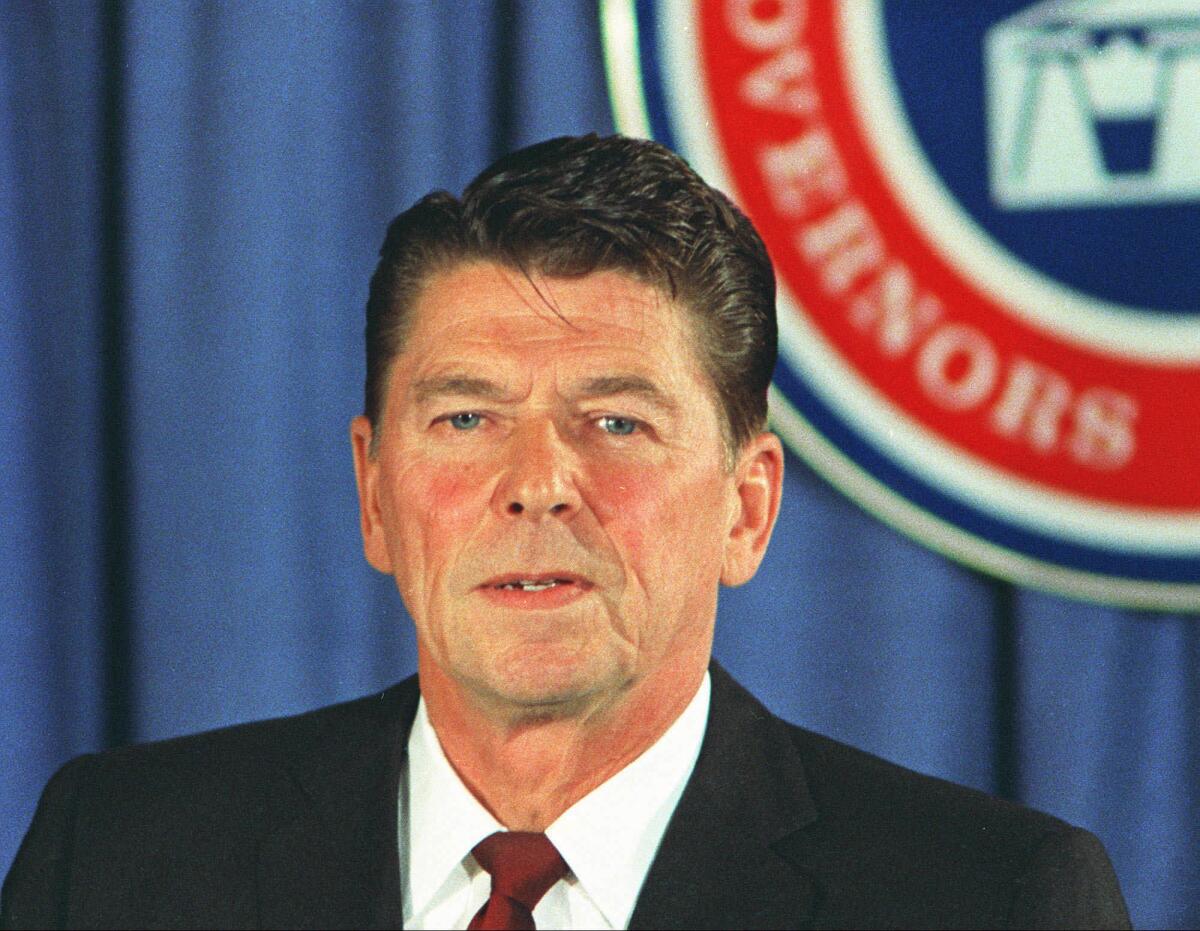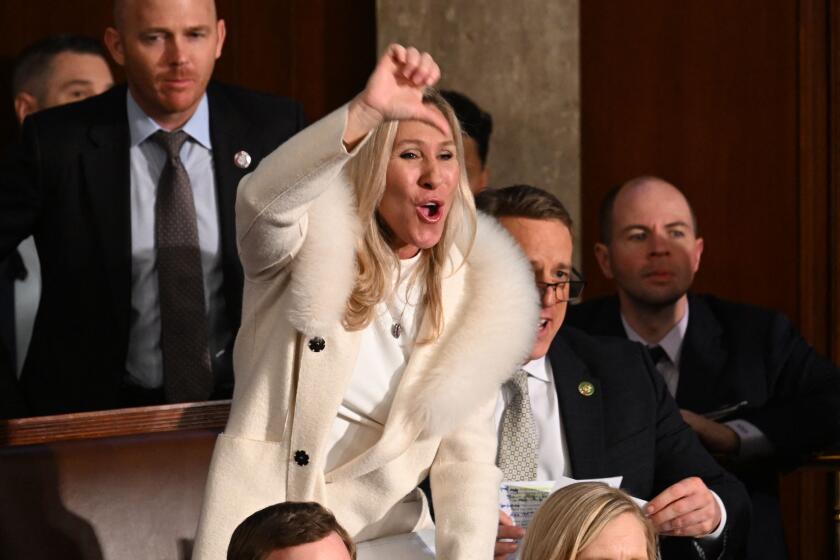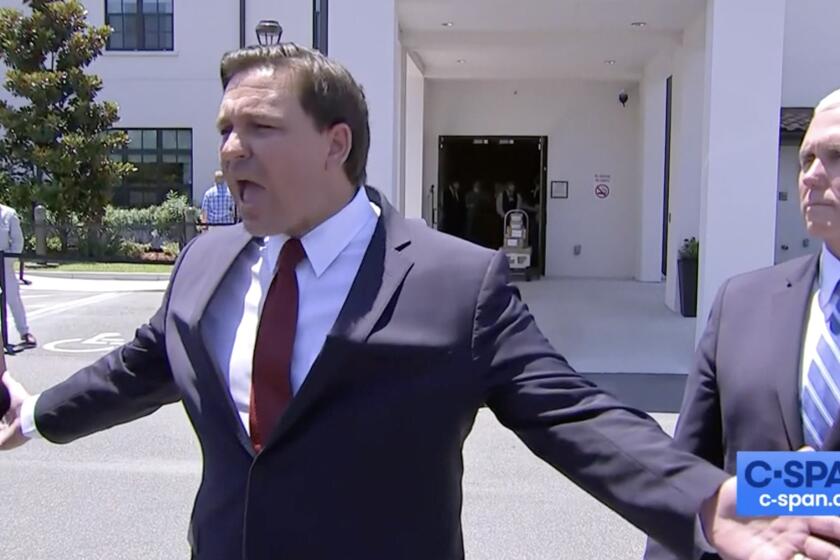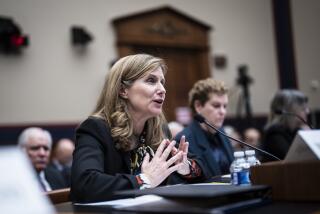Column: How DeSantis’ attack on education draws from Ronald Reagan’s war on UC Berkeley

The candidate strides to the podium and launches into his attack on his state’s educational system. Students are being “indoctrinated” with leftist propaganda by radical professors, he declares.
In office, he establishes a system of surveillance over what students are learning and doing. He advocates firing faculty members who stray from the official line, calls for narrowing the topics covered in textbooks (especially those dealing with minorities), and takes steps to replace administrators with people closer to his own politics. It’s all about “saving” the system, he insists, not tearing it down.
Florida Gov. Ron DeSantis, marching toward the Republican Party nomination for president? Nope. It’s Ronald Reagan, stirring up public discontent with the University of California and riding it toward the California governorship and, eventually, the White House.
A small minority of beatniks, radicals, and filthy speech advocates have brought shame on a great university.
— Ronald Reagan, 1966
The stark similarities between DeSantis’ attacks on educational practices in Florida and Reagan’s attacks on UC remind us that culture wars directed at public education are perennial features of right-wing electoral campaigns.
The similarities between the two cases are striking: an anti-intellectual undercurrent depicting teachers as carriers of alien, even anti-American, values; the imposition of political litmus tests on academic standards; the enforcement of orthodoxy through government power.
Get the latest from Michael Hiltzik
Commentary on economics and more from a Pulitzer Prize winner.
You may occasionally receive promotional content from the Los Angeles Times.
There are differences, of course, in the atmosphere of the times, the specifics of the attacks, and the character and personalities of the lead figures. But that only underscores the observation, often attributed to Mark Twain, that “history doesn’t always repeat itself, but it often rhymes.”
Let’s revisit Reagan’s war on Berkeley, then show how DeSantis, like other GOP culture warriors, draws from his playbook.
Berkeley was simmering with discontent in the mid-1960s, manifesting at first in protests supporting the civil rights movements. When administrators moved to quarantine political organizing and rallies off-campus, the Free Speech Movement, which became the chief instrument of protest, was born.
In December 1964, when the FSM led a takeover of Sproul Hall, the main administration building, Gov. Pat Brown sent in the police. Nearly 800 students were arrested.
Protests against the Vietnam War took root beginning in 1965. That May, the second national “teach-in” against the war (following an event in March at the University of Michigan) was held on campus, featuring prominent war critics from university faculties around the country.
Reagan and his campaign team didn’t immediately recognize the political potential of the Berkeley issue. In advance of the campaign, Reagan advisor Stuart Spencer told oral history interviewers a decade after the 1966 election, “campus unrest did not show up in our research as a major issue.”
During question-and-answer sessions at every campaign appearance, however, “somebody would get up and say, ‘What are you going to do about those bastards at Berkeley?’... We felt this underlying feeling, and we jumped on it.”
By capitulating to antiabortion forces and showing its cowardice, Walgreens abandons its own customers and its corporate principles.
The issue became the centerpiece of Reagan’s gubernatorial campaign. Speaking at a May 12, 1966, GOP rally in San Francisco’s cavernous Cow Palace — when he was still running for the Republican nomination — Reagan hammered away at how “a small minority of beatniks, radicals and filthy speech advocates have brought shame on a great university.”
He cited a report published only days before by a state Senate committee on un-American activities that called the campus “a rallying point for communists and a center for sexual misconduct.”
Reagan exploited the unrest at Berkeley to discredit his Democratic opponent, Gov. Edmund G. “Pat” Brown Sr., as weak and vacillating in a crisis. He also used the issue to undermine one of Brown’s signal achievements as governor.
This was the 1960 Master Plan for Higher Education, which established the UC as the state’s primary public academic institution; focused the California State University on undergraduate instruction and teaching degrees; and focused the system of two-year community colleges on academic and vocational education, remedial instruction, adult courses and workplace training. The plan also confirmed the principle that the system should be tuition-free to state residents.
Reagan’s other target was UC President Clark Kerr, a liberal educator of nationwide renown who had been the architect of the master plan but had been unable to figure out how to peacefully manage the Berkeley unrest.
Reagan used the issue to solidify his credentials as a “get tough” politician. At the Cow Palace, he said “the ringleaders” of the campus protests “should have been taken by the scruff of the neck and thrown out of the university, once and for all.”
He depicted himself as protector of the public’s investment in the university. The taxpayer, he said, is wondering “why some instructors are able to use the classrooms to indoctrinate and propagandize his children against the traditional values of a free society in this country.” As governor, he charged that “there are political tests in certain departments. ... If a man is not far enough left, he doesn’t get hired.”
Soon after taking office, Reagan goaded the UC Board of Regents, a 24-member body on which he had a single vote, into firing Kerr. Unlike his predecessors, he often attended regents meetings in person, turning the board into his “personal political arena,” an unnamed member complained to The Times in 1967. The board turned down Reagan’s demand to institute tuition at UC, but did agree to a “student charge” of unspecified size; this would open the door to tuition later.
Rick DeSantis and other conservatives are crowing about having killed off “woke” policies. But their celebration is way premature.
The low point of Reagan’s conflict with Berkeley came during the “Peoples Park” controversy of 1969, which concerned a weed-choked vacant lot that the university decided to turn into a playing field, over the objections of activists and local residents who agitated for a public greensward.
Matters escalated until May 15, known since then as “Bloody Thursday,” when state and local police summoned by Reagan arrived to quell street fighting. Some 128 residents were injured and one uninvolved spectator, watching from a distance, was shot and killed by police.
The park eventually became a homeless encampment, but controversy over its development has erupted again, now concerning UC’s proposal for student housing on the site.
DeSantis is plainly convinced — as was Reagan — that the gulf between ordinary voters and teachers and professors he describes as “elites” is wide enough to exploit for partisan ends.
Like Reagan, he is averse to compromise; determined to extirpate what he depicted as liberalism at the public New College of Florida, DeSantis installed a clutch of right-wingers on its board. They promptly fired its president, Patricia Okker, and set about remaking one of the country’s leading progressive educational institutions in the image of the right-wing christian Hillsdale College of Michigan.
(At a meeting with UC professors during the Peoples Park conflict, Reagan erupted at the observation by Berkeley physicist Owen Chamberlain, a Nobel laureate, that the park’s fate was being negotiated. “Negotiate?” he asked incredulously. “What is there to negotiate?” Then he stormed out of the meeting.)
DeSantis has strived to strip down classroom treatments of U.S. history, in ways that effectively whitewash the complex racial and racist currents of America’s past. This is the core of DeSantis’ war on “wokeness,” the definition of which he leaves vague — the better to intimidate teachers and textbook publishers wary of stepping over an invisible line — but which is properly viewed as a willingness to recognize the diversity of American cultures.
According to antiracism expert Ibram X. Kendi, Reagan also held a dismissive attitude toward Black and ethnic studies, subjects that were attracting pedagogical interest during his public career, disdaining them in a 1969 interview as efforts to find “sanctuary” from the normal rigors of academic study. As a UC regent, he demanded that the board fire Black activist Angela Davis from her post as a UCLA philosophy professor.
Outside the educational field, he launched his presidential campaign in Philadelphia, Miss., where civil rights workers James Chaney, Michael Schwerner and Andrew Goodman were murdered in 1964. In his speech, Reagan pronounced himself a supporter of “states’ rights,” a coded phrase for racism.
The College Board said that no states provided feedback on its AP Black studies course. But it received feedback from right-wing Florida Gov. Ron DeSantis as early as January 2022.
DeSantis is hardly the only Republican politician to target teachers and college professors for partisan purposes. The University of Wisconsin Board of Regents dramatically loosened tenure protections in 2016 at the behest of then-Gov. Scott Walker. Similar efforts have surfaced more recently in Texas, Kansas, Louisiana, Georgia and South Carolina.
Last April, DeSantis questioned whether tenure protects academic freedom, as its supporters maintain. “If anything, it’s created more of an intellectual orthodoxy where people that have dissenting views, it’s harder for them to be tenured in the first place,” he said, echoing Reagan’s complaints about discrimination against teachers who are not “far enough left.”
It’s true that DeSantis doesn’t have Reagan’s ability to project a sincere belief in his own words, a characteristic that contributed much to his popularity. Reagan also chose his targets carefully. As Kerr observed to The Times in 1973, Reagan never acted on his threats to get rid of politically active professors.
“He wasn’t restrained with the students,” Kerr reflected, “but he was with the faculty. A couple of serious academic freedom cases could have blown the place apart.” Reagan didn’t want that, for he viewed UC as “the foundation upon which California’s high-tech industry was based,” historian Gerard J. De Groot noted in 1996. During his tenure, UC was receiving 25% of all Defense Department research contracts.
DeSantis, by contrast, comes across less affably, as a bully interested in power for its own sake. He has specifically taken aim at faculties in Florida’s state university system, jeopardizing their reputations as research centers.
Reagan also never made the mistake of trying to chisel his educational policies into law, which would expose them to judicial scrutiny. By contrast, DeSantis and his sycophantic GOP-controlled Legislature have enacted laws dictating how teachers should teach and what textbooks should say.
As it happens, the courts have begun to pick apart DeSantis’ educational laws. On March 17, a federal appeals court maintained a block on DeSantis’s “Stop WOKE Law” that had been imposed in November by a federal judge who called it “positively dystopian.” The law prohibits certain school and university teachings related to race and gender history and relations.
DeSantis isn’t finished yet. His lickspittle Legislature has taken up consideration of a new law that calls for the elimination of majors and minors in race or gender studies, the end of “diversity, equity and inclusion” programs, and the end of guaranteed tenure protection.
Undoubtedly, as he continues his race for the GOP nomination for president, DeSantis will have more up his sleeve. If there’s hint that he may not succeed in his ambitions, it may be that we’re all familiar with Ronald Reagan, and we know he’s no Ronald Reagan.
More to Read
Get the latest from Michael Hiltzik
Commentary on economics and more from a Pulitzer Prize winner.
You may occasionally receive promotional content from the Los Angeles Times.










